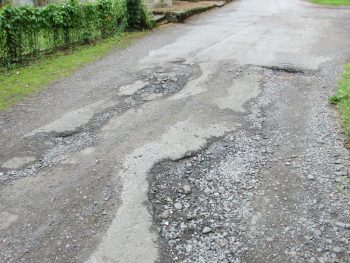Pothole breakdowns hit record high in Q3, RAC reports
RAC patrols dealt with a record number of pothole-related breakdowns in the third quarter, as the condition of UK roads goes from bad to worse.

The RAC says councils should start using surface dressing again
From July to September, its mobile team headed to the rescue of 5,978 drivers for damaged shock absorbers, broken suspension springs or distorted wheels – the faults most likely to be caused by wear and tear from broken road surfaces.
It’s the highest number of pothole-related breakdowns the RAC has seen in any third quarter since it began recording this data in 2006.
It’s also up by 580 callouts on the previous third-quarter high of 5,398 recorded in 2013 – and by 1,893 on the same period in 2022 when there were 4,085 pothole breakdowns – meaning this year has seen a 46% increase.
This rise has now bumped up the RAC Pothole Index, which tracks the probability of drivers suffering a pothole-related breakdown since 2006. The index has now increased to 1.7 which means motorists are nearly twice as likely to break down due to the repeated wear caused by potholes than they were 17 years ago.
The RAC’s figures, however, deliberately don’t include punctures as these are often caused by nails and screws as well as poor road surfaces. Between July and September RAC patrols went out to 101,000 puncture jobs, which is an 8% increase on the same period in 2022 which may imply that poor road surfaces were partially to blame.
Worse is on the cards for drivers too; the colder months of January to March are typically the worst for pothole breakdowns and the first quarter of 2021 still holds the record for the RAC’s highest number of pothole callouts in a quarter, standing at 14,827 drivers.
The RAC said a government spending pledge of £8.3bn over a five-year period should give local highways authorities the certainty of funding they need to be able to plan longer term road maintenance work.
But RAC head of policy Simon Williams added: “We have long argued that it’s not just a question of filling potholes, it’s about getting the roads in the worst condition resurfaced. Then, it’s vital that more councils start to make greater use of surface treatments which can cost effectively extend the lives of these roads.
“Our analysis of government data shows that many are no longer surfacing dressing their roads, which partly explains why so many are now peppered with potholes. Our message to government is therefore not just to get the potholes fixed, but to get councils using surface dressing again as this helps seal roads which prevents water getting in cracking the asphalt when the temperature drops to freezing.”
The RAC has also urged the Department for Transport to set out guidance for councils on how best to make use of their funding.
“Roads in better condition need to be kept that way through a combination of carrying out the most permanent pothole repairs possible, with those requiring more attention being surface dressed, while roads that are no longer fit for purpose must be fully resurfaced.
“If this approach is adopted, we believe we will eventually see lasting benefits and a welcome end to the pothole plague drivers have had to endure for far too many years.”
RAC recorded pothole-related breakdowns – full year: 1 October – 30 September
| To 30 September 2018 | To 30 September 2019 | To 30 September 2020 | To 30 September 2021 | To 30 September 2022 | To 30 September 2023 |
| 29,929 | 20,821 | 22,430 | 30,986 | 21,657 | 29,139 |
RAC recorded pothole-related breakdowns – third quarter, July to September
| Q3 2018 | Q3 2019 | Q3 2020 | Q3 2021 | Q3 2022 | Q3 2023 |
| 4,073 | 4,164 | 4,944 | 5,217 | 4,085 | 5,978 |















